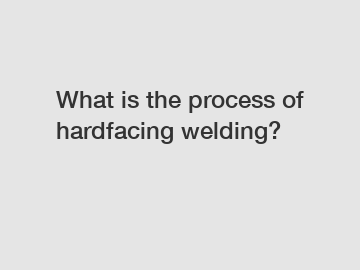Jan. 19, 2024
Mechanical Parts & Fabrication Services
If you are looking for more details, kindly visit JINHUA HARDFACING.
As industries continue to progress, the demand for durable and robust equipment grows. One technique that has gained immense popularity in recent years is hardfacing welding. This process is known to enhance the longevity and performance of various industrial components, yielding numerous benefits across a myriad of sectors. In this blog, we will delve into the process of hardfacing welding, shedding light on its intricacies, applications, and undeniable advantages.
Understanding Hardfacing Welding:

At its core, hardfacing welding involves depositing a protective layer of harder material onto a relatively softer base metal. The aim is to improve the wear resistance, toughness, and overall strength of the component. This process is commonly employed for materials exposed to extreme conditions, such as high temperatures, intense pressure, abrasion, or corrosion.
The Hardfacing Process Explained:
1. Assessing the Component: .
The first step is to inspect and analyze the component that requires hardfacing. This assessment helps determine the type of wear it endures, enabling the selection of appropriate hardfacing materials and techniques.
2. Material Selection:
Choosing the suitable hardfacing material is crucial as it directly affects the component's performance. Numerous options exist, ranging from alloys like tungsten carbide or chromium carbide to softer materials like stainless steel or iron-based alloys. The selection largely depends on the wear conditions and required performance characteristics.
3. Preparation:
Preparing the component surface involves meticulous cleaning to remove any dirt, grease, or paint. This ensures proper adhesion and maximizes the welding's effectiveness. Depending on the specific circumstances, the surface may require additional modifications, like beveling or grinding, to achieve optimal results.
4. Welding Techniques:
Various welding techniques can be employed in hardfacing, including manual metal arc welding, gas metal arc welding, submerged arc welding, and plasma arc welding. The choice of technique depends on factors such as material compatibility, component geometry, and complexity.
5. Application of Hardfacing Material:
Once the base metal is ready, the hardfacing material is applied using a chosen welding technique. It is crucial to achieve an even and consistent deposition to guarantee the desired results. Skilled operators closely monitor the process parameters, ensuring precise control over the process for optimal results.
6. Post-Welding Processing:
After completing the welding procedure, the hardfaced component may require additional steps to refine its surface. These may include machining, grinding, or polishing to achieve the desired dimensions and surface finish.
Applications of Hardfacing Welding:
Hardfacing welding finds extensive use in diverse industries, including mining, construction, oil and gas, agriculture, and manufacturing. Some common applications include:
1. Mining Equipment:
Components subjected to extreme abrasion, such as buckets, conveyor screws, and crusher jaws, benefit greatly from hardfacing. The protective layer significantly prolongs their lifespan, reducing maintenance costs and downtime.
2. Industrial Valves and Pumps:
Valves and pump parts experiencing erosion due to harsh fluids or particles can be successfully hardfaced, ensuring longer service life and heightened reliability.
3. Agricultural Machinery:
Within the agricultural sector, hardfacing is employed to enhance the durability of tillage tools, plows, and harvesters. By withstanding immense wear, these components can operate efficiently, even under harsh conditions.
4. Manufacturing Equipment:
Hardfacing is widely used on tools, dies, and roll surfaces, imparting increased resistance against the pressures of repetitive use and reducing the need for frequent replacements.
The Benefits of Hardfacing Welding:
1. Improved Wear Resistance:
Hardfaced components exhibit exceptional resistance to abrasion, impact, and erosion, resulting in prolonged service life and reduced downtime.
2. Increased Durability:
By reinforcing the base metal, hardfacing enables the component to withstand extreme operating conditions, ultimately leading to enhanced durability and reliability.
3. Cost Savings:
Utilizing hardfacing welding techniques allows businesses to save significantly on replacement costs, extended equipment lifespan, and reduced maintenance expenses.
4. Versatility:
From high-stress mining equipment to delicate manufacturing components, the hardfacing process offers versatility in protecting a wide range of materials and structures.
Conclusion:
Hardfacing welding is a powerful technique that can enhance the longevity, strength, and performance of engineering components across various industries. By choosing the appropriate hardfacing material, employing precise welding techniques, and closely monitoring the process, the desired exceptional results can be achieved. Embracing hardfacing welding in industries translates to increased equipment durability, prolonged component lifespan, reduced maintenance, and remarkable cost savings. With the ability to reinforce diverse materials against the harshest conditions, hardfacing welding serves as a key contributor to industrial durability and efficiency.
Please visit our website for more information on this topic.
If you are looking for more details, kindly visit flux cored hardfacing wire.
Previous: Revolutionize Your Plumbing System: Unveiling the Compact Check Valve for Ultimate Efficiency
Next: Which roller bearings offer the best price for motorcycle?
If you are interested in sending in a Guest Blogger Submission,welcome to write for us!
All Comments ( 0 )